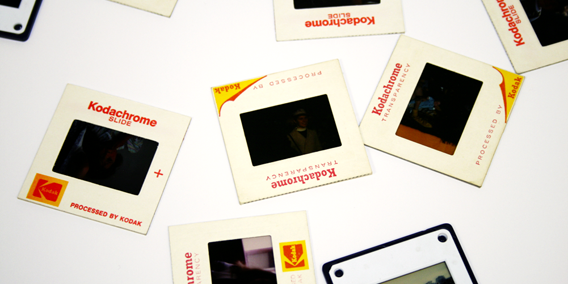We’re keen that The Pictorium blog becomes a resource for people, provides some tips and helps us share some of what’s happening – whether it’s interesting photos we come across or competitions that we’re running. We’re going to kick things off with a look at the once ubiquitous 35mm slide.
Growing up my dad was a keen snapper of family events and pretty much anything else that caught his eye. As proof of my decrepitude the world was non-digital – telephones were not only tethered to a single location with something called a ‘telephone cable’ but did not come with cameras. Strange times indeed….in this non-digital world cameras used film, which subsequently had to be developed to photographic prints – a pricey enough process when much like today, money was tight.
A cheaper alternative was to get slides, the most popular being 35mm. These were not only cheaper but had the added bonus of enabling the casual snapper to inflict upon several people his or her holiday snaps via a projector. In these barbaric times this was seen as a form of entertainment much akin to the X-Factor is today. To quote George Orwell “Progress is not an illusion; it happens, but it is slow and invariably disappointing.”
In any case my parents have buckets of 35mm slides lying about and I decided it might be worthwhile taking a look at a few of them. I immediately came across a great shot of my mother, taken by my father at a friends wedding.
Physically cleaning 35mm slides generally consists of shoving the dirt from the center of the slide to the edges where it butts up against the cardboard or plastic carrier. While a solution to this is to remove it from the carrier, you are then faced with getting it back in when finished. Hassle and grief and distinctly non-digital in a ‘telephone with a cable and no camera way’.
A quick wipe with a good quality clean microfibre cloth together with a gentle puff of compressed air and I am ready to boot up the scanner. I generally scan everything in 48-bit colour and 35mm slides at 6,400 DPI and always save as a tiff file. This all combines to make a big file but one that has plenty of detail and lots of pixels for us to shove around later in Photoshop.
Generally scanners ship with some software that includes colour restoration, dust removal and our Epson has something called Digital Ice Technology included as well.
Bad news is that none of this works particularly well – definitely not as well as what can be achieved in Photoshop with a bit of tender love and care. So I scan with it all turned off apart from the Unsharp Mask which I leave at a low setting.
In a future blog we hope to cover scanning in a bit more detail and it’s many intricacies, but for now below is the 35mm slide scan – a nice shot of my mother taken at a friends wedding by my father (casting a most unprofessional shadow across the photo, possible proof that sucking at photography is genetic…)
There’s a few elements of the photo that I’m not entirely happy with. Some dust and scratches are definitely visible and the colour could do with a bit of tweaking. At this stage I am thinking that a quick half hours work will result in a restored photo ready for printing and make a nice present for my mother. In a future blog we’ll walk through some of the processes we’re going to use to restore this photo.







